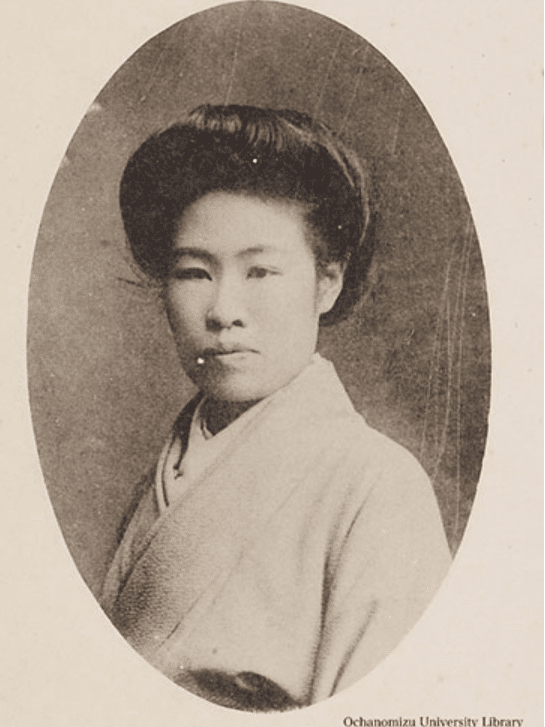
Happy Women's Map 佐賀県 日本の女性化学者の先駆け 黒田 チカ女史 / A Pioneering Female Chemist in Japan, Ms. Chika Kurota

「すべての物に親しみをもって向かえ ば,必ずものが教えてくれて道は開けますよ」
"Greet everything with familiarity, and surely things will teach you, opening the way."
黒田チカ 女史
Ms. Chika Kurota
1884 -1968
佐賀県佐賀市松原 生誕
Born in Saga-city, Saga-ken
黒田チカ女史は日本の女性化学者の先駆けです。帝国大学に入学した最初の女性であり、紫根、紅花、ウニなどの天然色素の研究に従事。彼女の天然色素に関する関連資料は、日本化学会が化学遺産に認定されています。東京女子高等師範学校(今のお茶の水女子大学)初の女性教授です。
Ms.Chika Kuroda is a pioneering female chemist in Japan. She was the first woman to enroll in an imperial university and conducted research on natural pigments such as purple root, safflower, and sea urchin. Her related materials on natural pigments have been recognized by the Chemical Society of Japan as chemical heritage. She was also the first female professor at Tokyo Women's Higher Normal School (now Ochanomizu University).
*******
「勉学に目覚める」
チカは佐賀藩諫早邑の藩士の家に7人きょうだいで生まれます。両親の進歩的な考えのもとチカは他のきょうだいとともに大学教育を受けます。チカは母親から三味線・琴を習いながら小学校に通います。小学校ではそろばんの割り算に四苦八苦するも、高等科で分数を明解に教える良き教師に出会って勉強に目覚めます。勧興小学校から佐賀師範学校女子部へと進み、17歳の時に卒業。チカは佐賀郡川副高等小学校の教師を1年務めた後に東京に出て女子高等師範学校(現在のお茶の水女子大学の前身)理科に進学します。平田敏雄教授の指導を受けて化学に対する情熱を持つも、当時の女子はこの先へ学歴を積む道は閉ざされており、理科教師として福井県立女子師範学校に就職します。活気に満ちた教師生活を満喫するも、1年後には周囲に勧められ、保井コノ(生物学)につぐ官費研究科生として母校に戻ります。2年間の研究科課程を修了し、チカは25歳で東京女子高等師範学校の助教授となります。
「化学に目覚める」
長井長義が東京女子高等師範学校に講師として招聘されてきます。長井は欧州において有機化学の第一線研究者であり、帝国大学薬科大学教授で日本薬学会会頭、さらに日本女子大学や双葉学園の設立に関わるなど女子教育にも熱心でした。「噂に承ったご風采に親しみと光栄を感じた」チカは大興奮しながら実験助手を務め、有機化学反応のための試薬作成など猛毒を扱う危険な作業で実験科学者としての技量を磨きます。さらに長井の強力な推薦により東京女高師出身の黒田チカ(化学科)と牧田ラク(数学科)、日本女子師範学校出身の丹下ムメ(化学科)の3人そろって日本初の帝国大学女性理学士となります。チカは日本における有機化学の育ての親である真島利行のもと天然色素紫根の研究をはじめます。高貴な色として珍重されるも色素の正体が分からず工業生産できなかった結晶を紫根から取り出しシコニン(Shikonin)と命名。さらに不安定なシコニンを様々な試薬と反応させて様子を観察、生成物を既知物質と比較しながら反応様式をひとつひとつ調べます。
「天然色素のわくわく」
1918年ようやくシコニンの構造について結論を得たチカは、この業績により34歳で東京女子高等師範学校に日本初女性教授として招かれます。日本化学会主催の紫根研究の講演会にはたくさんの聴衆はじめマスコミが集まります。チカは長井らの推薦を得て、英国オックスフォード大学のパーキン教授(W. H. Perkin)に留学。インドール誘導体の研究を任され、英国生活を満喫。「ホームシックになる暇もありませんでした」。帰国後、チカは紅花の赤い色素を研究テーマに選び、色素の結晶カーサミン(Carthamin)を取り出し、1930年に英国化学会誌『Journal of The Chemical Society』で発表。この業績によりチカは化学分野における日本女性初の理学博士となります。さらにつゆ草の青花の色素・黒豆や茄子の色素・紫蘇の色素・ウニの棘の色素など身近な色素の研究を行い、単離した結晶性色素をそれぞれアオバニン・クロマミン・ナスニン・シソニン・スピのクロムと命名、構造を明らかにします。さらにたまねぎの皮に約2%含まれるケルセチン(Quercetin)が高血圧の治療に有効であることを示し、チカ自身で錠剤づくりまで行って高血圧治療薬「ケルチンC」として発売。第二次世界大戦後、チカを会長として日本婦人科学者の会が発足。ならびにお茶の水女子大学が発足、チカは理学部化学科の教授となって定年退官後も名誉教授として後進の指導にあたります。
"Awakening to Learning"
Chika was born into a family of seven siblings in the town of Isahaya, belonging to the Saga Domain samurai. Under the progressive mindset of her parents, Chika, along with her siblings, received a university education. While learning shamisen and koto from her mother, she attended elementary school. Struggling with soroban (abacus) division in elementary school, she awakened to studies when she encountered a good teacher who explained fractions clearly in the advanced classes. Advancing from Kanko Elementary School to Saga Normal School for Girls, she graduated at the age of 17. After working as a teacher at Kawasoe Elementary School in Saga for a year, Chika moved to Tokyo, entered the Women's Higher Normal School (predecessor of the current Ochanomizu University), and majored in science. Under the guidance of Professor Toshio Hirata, she developed a passion for chemistry. However, at that time, the path for women to pursue higher education was limited, and she took a job as a science teacher at the Fukui Prefectural Women's Normal School. Although she enjoyed a lively teaching life, encouraged by those around her, she returned to her alma mater as a government-funded research student following Konoyi Yasui (biology). After completing the two-year research program, Chika, at the age of 25, became an assistant professor at Tokyo Women's Higher Normal School.
"Awakening to Chemistry"
Nagai Nagayoshi was invited as a lecturer to Tokyo Women's Higher Normal School. Nagai was a leading researcher in organic chemistry in Europe, a professor at the Imperial University Pharmaceutical College, president of the Japan Pharmaceutical Association, and actively involved in women's education, including the establishment of Japan Women's University and Futaba Gakuen. Feeling a sense of familiarity and honor upon hearing rumors about his distinguished presence, Chika enthusiastically served as a research assistant. She honed her skills as an experimental scientist, handling dangerous tasks such as preparing reagents for organic chemistry reactions. With Nagai's strong recommendation, three women, Kuroda Chika (Chemistry), Makita Raku (Mathematics), both from Tokyo Women's Higher Normal School, and Tange Mume (Chemistry) from Japan Women's Normal School, became the first female Bachelor of Science recipients in the Imperial University in Japan. Under the guidance of Toshiyuki Majima, a pioneer in organic chemistry in Japan, Chika began her research on the natural dye shikonin extracted from the roots of the Lithospermum erythrorhizon plant. Highly valued for its noble color, she named the crystalline substance extracted from shikonin "Shikonin." Despite the inability to understand the true nature of the dye and its industrial production, Chika conducted experiments by reacting the unstable Shikonin with various reagents, observing the results, and systematically examining the reaction patterns by comparing the products with known substances.
"Excitement of Natural Pigments"
In 1918, at the age of 34, Chika finally reached conclusions about the structure of Shikonin. This achievement led to her being invited as the first female professor at Tokyo Women's Higher Normal School. A lecture on shikonin research organized by the Chemical Society of Japan attracted a large audience, including the media. With recommendations from figures like Nagai, Chika went on to study abroad under Professor W. H. Perkin at the University of Oxford in the UK. Entrusted with the research on indole derivatives, she enjoyed her time in the UK, saying, "I didn't even have time to get homesick." Upon her return, Chika chose the red pigment of safflower as her research theme and extracted the crystal carthamin, presenting her findings in the Journal of The Chemical Society in 1930. This work earned her the title of the first Japanese woman to receive a Ph.D. in chemistry. She further conducted research on familiar pigments such as the blue pigment of bellflower, the pigment of black soybeans and eggplants, the pigment of perilla leaves, and the pigment of sea urchin spines. Isolating crystalline pigments, she named them Aobanin, Kuromamin, Nasunin, Shisonin, and Supi no Kuromu, respectively, elucidating their structures. Additionally, she demonstrated that quercetin, present in about 2% of onion skin, is effective in treating hypertension. Chika personally formulated tablets and released them as the hypertension medication "Quercetin C." After World War II, Chika became the president of the Japan Association of Women Scientists. She also played a significant role in the establishment of Ochanomizu University, becoming a professor in the Chemistry Department and later an honorary professor, continuing to mentor future generations even after retiring.
-日本化学会 Chemical Society of Japan
-お茶の水女子大学歴史資料館 Ochanomizu Women's Univ. Museum

Share Your Love and Happy Women's Story!
あなたを元気にする女性の逸話をお寄せください!
Share your story of a woman that inspires you!
この記事が気に入ったらサポートをしてみませんか?
